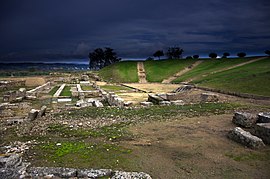Elis (city)
Ἦλις | |
 Remains of the theatre of Elis | |
| Region | Peloponnese |
|---|---|
| Coordinates | 37°53′29″N 21°22′30″E / 37.89131°N 21.37493°E |
| Part of | Ancient Elis |
Elis (
Elis is mentioned as a town of the
Soon after the
When Pausanias visited Elis, it was one of the most populous and splendid cities of Greece. By the mid-19th century, however, nothing of it remained except some masses of tile and mortar, several wrought blocks of stone and fragments of sculpture, and a square building about 20 feet (6.1 m) on the outside, which within is in the form of an octagon with niches. With such scanty remains it would be impossible to attempt any reconstruction of the city, and to assign to particular sites the buildings mentioned by Pausanias.[8]
Strabo says that the gymnasium stood on the side of the river Peneius; and it is probable that the gymnasium and agora occupied the greater part of the space between the river and the citadel.[9] The gymnasium was a vast enclosure surrounded by a wall. It was by far the largest gymnasium in Greece, which is accounted for by the fact that all the athletes in the Ancient Olympic Games were obliged to undergo a month's previous training in the gymnasium at Elis. The enclosure bore the general name of Xystus, and within it there were special places destined for the runners, and separated from one another by plane-trees. The gymnasium contained three subdivisions, called respectively Plethrium, Tetragonum, and Malco: the first so called from its dimensions, the second from its shape, and the third from the softness of the soil. In their Malco was the senate-house of the Eleians, called Lalichium from the name of its founders: it was also used for literary exhibitions.
The gymnasium had two principal entrances, one leading by the street called Siope or Silence to the baths, and the other above the
The theatre must have been on the slope of the acropolis: it is described by Pausanias as lying between the agora and the Menius, which, if the name is not corrupt, must be the brook flowing down from the heights behind the old town. Near the theatre was a temple of Dionysus, containing a statue of this god by Praxiteles.
On the acropolis was a temple of Athena, containing a statue of the goddess in gold and ivory by Pheidias. On the summit of the acropolis are the remains of a castle, in the walls of which Ernst Curtius noticed, when he visited in the 19th century, some fragments of Doric columns which probably belonged to the temple of Athena.
In the immediate neighbourhood of Elis was Petra, where the tomb of the philosopher Pyrrho was shown.[10]
The acropolis of Elis is now called Kalokaspoi in Greek and the
Notable people
References
- ^ Supplementum Epigraphicum Graecum 12.371.38
- ^ Strabo. Geographica. Vol. viii. p. 337. Page numbers refer to those of Isaac Casaubon's edition.
- ^ Homer. Iliad. Vol. 2.615.
- ^ Diodorus Siculus. Bibliotheca historica (Historical Library). Vol. 11.54.
- ^ Strabo. Geographica. Vol. viii. p.336. Page numbers refer to those of Isaac Casaubon's edition.
- ^ Xenophon. Hellenica. Vol. 3.2.27.
- ^ Pausanias (1918). "9.5". Description of Greece. Vol. 5. Translated by W. H. S. Jones; H. A. Ormerod. Cambridge, Massachusetts; London: Harvard University Press; William Heinemann – via Perseus Digital Library.- 6.
- ^ Pausanias (1918). "23.1". Description of Greece. Vol. 6. Translated by W. H. S. Jones; H. A. Ormerod. Cambridge, Massachusetts; London: Harvard University Press; William Heinemann – via Perseus Digital Library. et seq.
- ^ Strabo. Geographica. Vol. viii. p. 337. Page numbers refer to those of Isaac Casaubon's edition.
- ^ Pausanias (1918). "24.5". Description of Greece. Vol. 6. Translated by W. H. S. Jones; H. A. Ormerod. Cambridge, Massachusetts; London: Harvard University Press; William Heinemann – via Perseus Digital Library.
 This article incorporates text from a publication now in the public domain: Smith, William, ed. (1854–1857). "Elis". Dictionary of Greek and Roman Geography. London: John Murray.
This article incorporates text from a publication now in the public domain: Smith, William, ed. (1854–1857). "Elis". Dictionary of Greek and Roman Geography. London: John Murray.- Gardner, Ernest Arthur (1911). . In Chisholm, Hugh (ed.). Encyclopædia Britannica. Vol. 9 (11th ed.). Cambridge University Press. p. 279.

